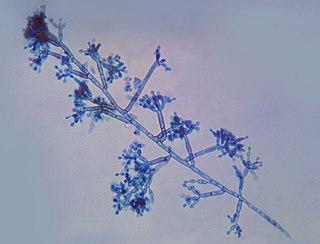Related Research Articles

Order is one of the eight major hierarchical taxonomic ranks in Linnaean taxonomy. It is classified between family and class. In biological classification, the order is a taxonomic rank used in the classification of organisms and recognized by the nomenclature codes. An immediately higher rank, superorder, is sometimes added directly above order, with suborder directly beneath order. An order can also be defined as a group of related families.

The Boletales are an order of Agaricomycetes containing over 1300 species with a diverse array of fruiting body types. The boletes are the best known members of this group, and until recently, the Boletales were thought to only contain boletes. The Boletales are now known to contain distinct groups of agarics, puffballs, and other fruiting-body types.

Eurotiomycetes is a large class of ascomycetes with cleistothecial ascocarps within the subphylum Pezizomycotina, currently containing around 3810 species according to the Catalogue of Life. It is the third largest lichenized class, with more than 1200 lichen species that are mostly bitunicate in the formation of asci. It contains most of the fungi previously known morphologically as "Plectomycetes".

Sordariomycetes is a class of fungi in the subdivision Pezizomycotina (Ascomycota). It is the second-largest class of Ascomycota, with a worldwide distribution that mostly accommodates terrestrial based taxa, although several can also be found in aquatic habitats. Some are phytopathogens that can cause leaf, stem, and root diseases in a wide variety of hosts, while other genera can cause diseases in arthropods and mammals.

The Leotiomycetes are a class of ascomycete fungi. Many of them cause serious plant diseases.

Petter Adolf Karsten was a Finnish mycologist, the foremost expert on the fungi of Finland in his day, and known in consequence as the "father of Finnish mycology".

The Chaetothyriales are an order of ascomycetous fungi in the class Eurotiomycetes and within the subclass Chaetothyriomycetidae. The order was circumscribed in 1987 by mycologist Margaret Elizabeth Barr-Bigelow.
Hyphochytrids are eukaryotic organisms in the group of Stramenopiles (Heterokonta).

Capnodiales is a diverse order of Dothideomycetes, initially based on the family Capnodiaceae, also known as sooty mold fungi. Sooty molds grow as epiphytes, forming masses of black cells on plant leaves and are often associated with the honeydew secreted by insects feeding on plant sap. This diverse order has been expanded by the addition of several families formerly thought unrelated and now also includes saprobes, endophytes, plant pathogens, lichens and rock-inhabiting fungi. The new additions include the genus Mycosphaerella containing the causal agents of several economically important crop and tree diseases. A small number of these fungi are also able to parasitise humans and animals, including species able to colonise human hair shafts.

The Phanerochaetaceae are a family of mostly crust fungi in the order Polyporales.
Lyromma is a genus of foliicolous (leaf-dwelling) lichens, and the sole member of Lyrommataceae, a family in the order Chaetothyriales. The genus was circumscribed in 1965 by Brazilian mycologists Augusto Chaves Batista and Heraldo da Silva Maia, with Lyromma nectandrae assigned as the type species. The family was proposed by Robert Lücking in 2008. Characteristics of the genus include the spherical to short barrel-shaped perithecia and elongated barrel-shaped pycnidia, and smooth thalli of rounded patches formed by its symbiotic relationship with green algae from the genus Phycopeltis.

Stereopsis is the sole genus of fungi in the family Stereopsidaceae. The genus was formerly placed in the family Meruliaceae in the order Polyporales but was found to belong in its own order along with the genus Clavulicium. Stereopsis was circumscribed by English mycologist Derek Reid in 1965. It contains species that form funnel-shaped basidiocarps as well as the corticioid species Stereopsis globosa which was formerly considered a species of Clavulicium. The species Stereopsis humphreyi and Stereopsis vitellina were found to belong in the Agaricales and Atheliales respectively in a molecular phylogenetics study, and because of this do not belong in Stereopsis, but they have not yet been transferred to their own genera.

Arachnomyces is a genus of cleistothecial ascomycete fungi described in 1902, of which the anamorph (asexual) stage is the genus Onychocola. Although morphologically similar to members of other families, the fungus now belongs to its own monotypic family Arachnomycetaceae, which is the only family in the monotypic order Arachnomycetales.
Olpidiaceae is a fungal plant pathogen family of genera that was placed in the order Olpidiales.

André Aptroot is a Dutch mycologist and lichenologist. His primary research focus is on biodiversity, particularly tropical lichens, encompassing systematics, floristic surveys, and taxonomic reviews. A prolific researcher, he has published more than 500 scientific papers and described hundreds of new fungal and lichen species.

The Irpicaceae are a family of mostly polypores and crust fungi in the order Polyporales.
References
- ↑ Kirk PM, Cannon PF, Minter DW, Stalpers JA (2008). Dictionary of the Fungi (10th ed.). Wallingford, UK: CABI. p. 419. ISBN 978-0-85199-826-8.
- ↑ Batista AC, Vital AF (1957). "Um novo Gasteromiceto da família Mesophelliaceae". Anais da Sociedade de Biologia de Pernambuco (in Spanish). 15 (1): 13–8.